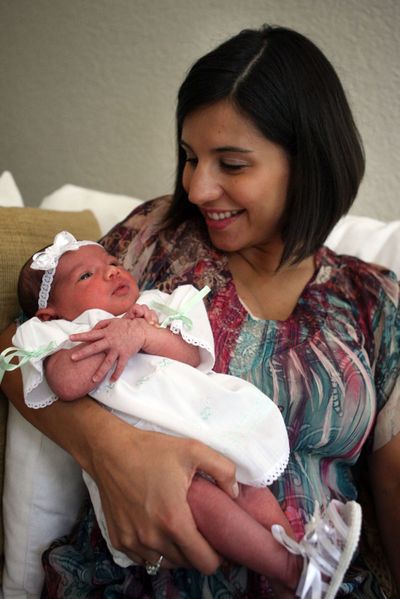Power of blood
Stem cells from umbilical cord can be used to treat diseases in others

MIAMI – When Jennifer Garcia scheduled the birth of her daughter at South Miami Hospital, nurses asked her an unusual question: “After your baby is born, are you willing to donate the umbilical cord to save someone’s life?”
She said yes: “What’s the point of throwing it in the trash if it can help other people?”
When Natalia Garcia, 7 pounds and 6 ounces, arrived at 3:56 p.m. on a recent Wednesday, the blood from the cord and placenta – about a quarter cup – was collected by those nurses, working in the hospital’s new public Cord Blood Donation Center.
They flew it to a lab at Duke University in North Carolina, and the stem cells were spun off and stored at minus 320 degrees Fahrenheit. The cells became part of a rapidly growing national bank of cord blood stem cells waiting to treat patients with leukemia, lymphoma, multiple myeloma, aplastic anemia, sickle cell and other diseases.
Scientists are now discovering the power of cord blood stem cells, which are easier to collect and can be used more flexibly than bone marrow stem cells traditionally employed to fight blood diseases.
South Miami Hospital’s new center – one of only five in the state – is part of an expanding network of centers for a new therapy that has grown up over the past five years, using flexible umbilical cord blood stem cells instead of harder-to-extract bone marrow stem cells to fight blood diseases.
“This can make a real difference in giving doctors a choice of treatment,” says Kathy Welte, director of the national Cord Blood Center in Minneapolis.
The new collection center, which opened in January, is especially welcome because of South Florida’s diverse population, since minorities are seriously under-represented in the stem cells stored so far, she said.
South Miami Hospital’s center came about after stem cells from centers in New York and Germany in 2007 treated the leukemia of the son, then 9, of one of the hospital’s cardiologists.
“Those cells saved his life, and they came from umbilical cords, something we’d just been throwing away,” says Dr. Harry Aldrich, who asked that his son’s name not be used.
The case of Aldrich’s son demonstrates the power of cord blood stem cells. At 9, the boy had acute myelogenous leukemia, a cancer of the blood that starts in the bone marrow.
Standard chemotherapy didn’t work. Doctors said he needed a stem cell transplant. So Aldrich began looking for a bone marrow donor, which can take months. No well-enough-matched donor could be found in the entire country.
Success story
But Aldrich had heard of a newer way of attacking leukemia – with stem cells from umbilical cord blood. The Cord Blood Center in Minneapolis quickly found two matches for the boy – one in New York, one in Germany.
The boy began treatment in March 2007. High doses of chemotherapy first destroyed his cancerous bone marrow. Umbilical cord stem cells were then injected into a vein leading to his heart. The new cells became part of his bone marrow, replacing the cells destroyed by chemotherapy, creating new, healthy blood cells and rebuilding his immune system.
Aldrich’s son is now 11 and finishing fifth grade, having helped his team win a few rounds in his school’s Geography Club Bee. He’s been off all cancer drugs since January 2008.
One reason a quick match could be found was that umbilical cord blood stem cells don’t have to match the recipient as closely as do stem cells from bone marrow. Starting at almost zero in 2000, umbilical cords now are the source of 21 percent of stem cell transplants.
Still, they won’t replace bone marrow stem cells. It takes stem cells from more than one umbilical cord to treat patients larger than a child or small adult, which complicates matching. Also, umbilical cord blood stem cells take longer to “engraft” into the patient and start producing new blood cells, leaving patients weaker longer.
When a patient receives a stem cell transplant, the direct cost is about $25,000, doctors say. The entire treatment can be $200,000 or more. Some insurance companies pay; others don’t.
South Miami Hospital was enthusiastic about creating the new cord blood donation center, said Denise Woods, assistant vice president.
“We deliver 4,500 babies a year,” she said. “Nearly 80 percent of the mothers who are eligible take part.” In its first nine weeks, the South Miami center collected blood from 198 cords, she said.